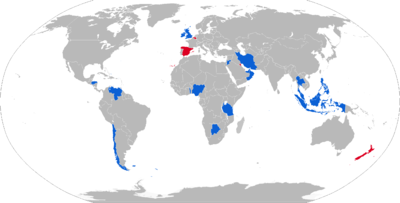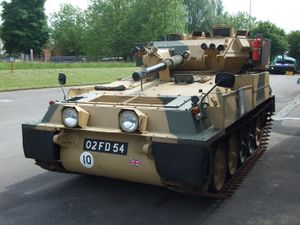إف في 101 سكوربيون
| FV101 Scorpion | |
|---|---|
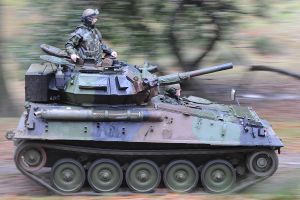 Irish Army Scorpion CVR(T) | |
| النوع | Reconnaissance vehicle |
| مكان الأصل | United Kingdom |
| تاريخ الخدمة | |
| في الخدمة | 1973–present |
| يستخدمه | Operators |
| الحروب | Iran–Iraq War[1] Falklands war Gulf war |
| تاريخ الانتاج | |
| الصانع | Alvis Vehicles, Coventry, England |
| التنويعات | Scorpion 90 |
| المواصفات | |
| الوزن | 17,800 lb (8.074 tonnes) |
| الطول | 5.288 m (17 ft 4.2 in)[2] |
| العرض | 2.134 m (7 ft 0 in)[2] |
| الارتفاع | 2.102 m (6 ft 10.8 in)[2] |
| الطاقم | 3[2] |
| الدرع | Aluminium armour, Cast and 1318b plate |
التدريع الرئيسي | ROF 76mm L23A1 gun 90 mm in Scorpion 90[2] |
التدريع الثانوي | Coaxial 7.62 mm L43A1 machine gun[2] |
| المحرك | Cummins BTA 5.9-litre (diesel)[2] 190 hp (140 kW) |
| القدرة/الوزن | 22.92 hp (17.3 kW) / tonne[2] |
| نقل الحركة | Self Change Gears TN15X[2] |
| التعليق | Torsion-bar |
المدى العملياتي | 756 km (470 mi)[2] |
| السرعة | 72.5 km/h (45.0 mph)[2] |
إف ڤي سكورپيون إنگليزية: FV101 Scorpion دبابة خفيفة بريطانية، صُنعت من قبل شركة ألفيس فيكرز ، دخلت الخدمة في الجيش البريطاني سنة 1973 وخرجت منه سنة 1994، أنتج من الدبابة 3,000 نسخة وقد عدت واحدة من أسرع الدبابات في العالم.
قصد في تصميم السكوربيون أن تكون عربة استطلاع خفيفة تنقل جواً وأن تكون في ذات الوقت سريعة الحركة وعليه فقد صنع درعها بشكل أساسي من الألمنيوم وزودت المركبة بمدفع L23A1 من عيار 76 ملم يطلق قذائف شديدة الانفجار وقذائف الخارقة للدرع لمدى يصل إلى 1600 متر إضافة إلى قنابل الدخان ، يتكون طاقم السكوربيون من 3 أفراد وتصل سرعتها إلى 80 كم بالساعة.
التسليح
| L23A1 gun | |
|---|---|
| مكان الأصل | المملكة المتحدة |
| تاريخ الخدمة | |
| في الخدمة | 1973–present |
| تاريخ الانتاج | |
| الصانع | Royal Ordnance |
| المواصفات | |
| الطول | 2.157 m (7 ft 0.9 in) |
| العيار | 76 mm (3.0 in) |
| معدل النيران | 6 rounds per minute |
| Effective firing range | 2،200 m (2،400 yd) |
The Scorpion was armed with the low velocity 76 mm L23A1 gun, which could fire high-explosive, HESH, smoke and canister rounds. Stowage was provided for 40 or 42 rounds. A 7.62 mm coaxial machine gun (3,000 rounds carried) was also fitted, as were two multi-barreled smoke grenade dischargers, one on each side of the turret.[2] The main armament has an elevation of 35 degrees and a depression of 10 degrees; the turret has a full 360-degree traverse.[3]
المحرك
The original engine was the Jaguar J60 Mk 100b 4.2-litre petrol engine,[4] which was replaced by a Cummins or Perkins diesel engine.[2] The maximum speed was about 50 أميال في الساعة (80 km/h) and it could accelerate from nought to 30 أميال في الساعة (48 km/h) in 16 seconds. The maximum speed on water (with the flotation screen deployed) was 3.6 mph (5.8 km/h).[5] The Irish engineering company IED replaced the existing Jaguar engine in a successful re-powering process with a Steyr M16 TCA HD engine (6-cylinder, 145 kW), making the Scorpion more powerful and more reliable in critical environments.[6][المصدر لا يؤكد ذلك]
التدريع
The FV101 was a very light armoured vehicle, weighing in at a mere 8 tonnes. This meant some compromises had to be made on protection. The vehicle had at least 12.7 mm[7] of aluminium armour all around, giving it 'ballistic immunity' against small low-velocity shrapnel and standard ball rifle rounds from cartridges such as 7.62×39mm, 5.56×45mm, and 7.62×51mm, all over the front 30 deg arc. Initial manufacture of the aluminium armour resulted, after time and effects of the environment, in failure. This phenomenon was known as Stress Corrosion Cracking (SCC) and it seriously affected all early builds.
أنظمة أخرى
The vehicle was fitted with a nuclear, biological, chemical protection system, image intensification sights for gunner and driver and a floatation screen.[2] A commode was located under the commander's seat, an internal water tank and a boiling vessel for cooking and heating water were also provided.[8]
سكورپيون 90
The Scorpion 90 or Scorpion 2 was a version armed with the long-barrelled Cockerill Mk3 M-A1 90mm gun designed for the export market.[9]
تاريخ الخدمة
The Scorpion was or is used by the armed forces of Belgium, Botswana, Brunei, Chile, Honduras, Iran, Indonesia, Ireland, Jordan, Malaysia, New Zealand, Nigeria, Oman, Philippines, Spain, Tanzania, Thailand, Togo, Venezuela and the United Arab Emirates.[2] Iranian army acquired 250 Scorpions in the late 1970s and a number of them are still in use after being refurbished locally as the Tosan tank. While Canada never operated the Scorpion, its original turret was married with the MOWAG Piranha I chassis to create the AVGP Cougar fire support vehicle, which was used by the Canadian Armed Forces. The Scorpion on occasion deployed to main UK airports as a measure against possible terrorist threats, e.g., Operation Marmion at Heathrow Airport in 1974.[10][المصدر لا يؤكد ذلك] Similar operations in 2003 used the then-current Scimitar.
الاستخدام في القتال
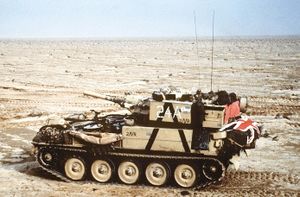
Two troops from B Squadron, Blues and Royals served in the Falklands War. One troop was equipped with four Scorpions, the other with four FV107 Scimitars. These were the only armoured vehicles used in action by the British Army during the conflict.[11] Scorpions also served in the Gulf War. The 1st The Queen's Dragoon Guards, a reconnaissance regiment, had 32 and the close reconnaissance troops of the armoured regiments each had eight.[12] They were also used by 1 Squadron RAF Regiment, which was attached to the 1st British Armoured Division.
المستخدمون الأجانب
Some small armies, such as the Botswana Defence Force and the Irish Army, and notably the larger Philippine Army and Nigerian Army continue to use the Scorpion, in some cases up-armed with the 90 mm Cockerill.
The Iranian army used its Scorpion tanks in the Iran–Iraq War, with various degrees of success. Early in the war, Iranians used the Scorpions's "accurate fire" (alongside the Cobra attack helicopters) to hold back Iraqi 2nd Infantry Division's offensive towards the city of Ilam.[1] However, the Scorpions proved less effective when faced with Iraq's 9th Armoured Division:[1]
A second [Iraqi] column rushed to Susangerd, which it crossed without encountering any resistance, the city having apparently been left defenseless. The column continued in the direction of Hamidiyeh. It came into contact with the [Iranian] 92nd Armored Division's reconnaissance regiment, which met it with effective in-depth defense. Yet the Iranians eventually had to yield in the face of Iraqi pressure. Their Scorpions' 90 mm guns did not hold their weight against the T-62 tanks' 115 mm guns. The Iraqis thus took control of Hamidiyeh, then Bozorg.
The British government provided Iran (and Iraq) with limited parts for their Scorpions during the war:[1]
Regarding military matters, the British government imposed two strict rules: contracts signed before the war would be honored, but the sale of equipment likely to significantly increase either side's military capacities was banned. Interpreting these regulations loosely, the British government delivered both the Iranians and the Iraqis motors and spare parts for Chieftain and Scorpion tanks, which would allow the former to maintain tanks acquired under the Shah and the latter to repair tanks captured from the Iranian army.
سيبر
The Scorpion has been withdrawn from British Army service and the refurbished hulls have been mated with surplus turrets from the FV 721 Fox CVR(W) wheeled reconnaissance vehicle to form a composite vehicle—the Sabre reconnaissance vehicle.[13]
سلامندر
A small number of converted Scorpions are in use at British Army Training Unit Suffield in Canada as part of OPFOR. With the main armament barrel replaced with a dummy they represent 125mm gun armed T-80-type vehicles.
المشغلون
مشغلون حاليون
- 1,500 units.
- 60 units.
- 16 units.
- 30 units; in service with the Chilean Marines Corps.
- 19 units.
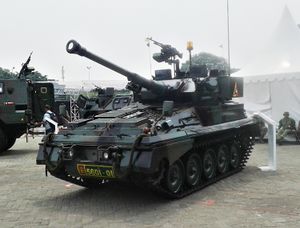 Indonesian FV 101 Scorpion on IIMS 2014
Indonesian FV 101 Scorpion on IIMS 2014 إيران
إيران
- 130 units.
- 90 units.
- 14 units.
- 80 units.
- 26 units.
- 150 units.
- 120 Units.
- 65 units.
- 128 units.
- 40 units.
- 12 units. Including one FV-106 Samson, one FV-104 Samaritan and one Fv-105 Sultan.
- 76 Units.
- 78 Scorpion 90, 4 or 6 FV-104 Samaritan, 2 FV-105 Sultan and 4 FV-106 Samson.[2]
مشغلون سابقون
- 701 units (this total consists of all seven variants of the CVR(T)).
- Limited number captured from Iran during Iran–Iraq War[14]
- Unknown.
- 17 units on service until 2009 on the Spanish Navy, (Infantería de Marina Española). Sold to Chile. There are a couple of units on static display as of 2011.
انظر أيضاً
- Combat Vehicle Reconnaissance (Wheeled)
- Other CVR(T) vehicles
- FV102 Striker anti-tank guided weapon carrier
- FV103 Spartan armoured personnel carrier[15]
- FV104 Samaritan armoured ambulance[15]
- FV105 Sultan command post vehicle[15]
- FV106 Samson armoured recovery vehicle[15]
- FV107 Scimitar armoured reconnaissance vehicle[16]
- Sabre – Scorpion chassis retro-fitted with a turret from the Fox Armoured Reconnaissance Vehicle
- Alvis Stormer – a larger development of the CVR(T) used in the case of the British Army to carry the Starstreak High Velocity Missile system[17] and the Shielder minelaying system.[18]
- AVGP Cougar Canadian wheeled armoured vehicle fitted with the turret from a Scorpion.[19]
- Medium Reconnaissance Vehicle (MRV) an Australian M113A1 fitted with the turret from a Scorpion.
- Tosan, Iranian-built development of Scorpions supplied to Iran in the 1970s, carrying a 90mm gun and Toophan ATGM
الهامش
- ^ أ ب ت ث Razoux, 2015
- ^ أ ب ت ث ج ح خ د ذ ر ز س ش ص ض ط "Scorpion". Jane's Information Group. Retrieved 2009-01-11.
- ^ Foss & Sarson, p. 14
- ^ Christopher Chant A compendium of armaments and military hardware. Retrieved 2014-05-31.
- ^ Foss & Sarson, p. 12
- ^ Application Gallery: Steyr-Motors.com
- ^ Thailand Army Weapon Systems Handbook.
- ^ Foss & Sarson, p. 11
- ^ Foss & Sarson, p. 37
- ^ Hughes, Geraint (2011). The Military's Role in Counterterrorism: Examples and Implications for Liberal Democracies. US Army War College, Carlisle, PA: Strategic Studies Institute. p. 91. ISBN 1584874899.
- ^ Foss & Sarson, p. 21
- ^ Foss & Sarson, pp. 41–44
- ^ Foss & Sarson, p. 34
- ^ "Former Equipment of Iraqi Army". Archive.org. Retrieved 17 July 2018.
- ^ أ ب ت ث "Spartan and Other CVR(T) Vehicles". MOD. Archived from the original on 2009-01-14. Retrieved 2010-01-14.
{{cite web}}: Unknown parameter|deadurl=ignored (|url-status=suggested) (help) - ^ "Scimitar Armoured Reconnaissance Vehicle". MOD. Archived from the original on 26 January 2009. Retrieved 2010-01-14.
{{cite web}}: Unknown parameter|deadurl=ignored (|url-status=suggested) (help) - ^ "Starstreak High Velocity Missile Vehicles". MOD. Archived from the original on 13 January 2009. Retrieved 2010-01-14.
{{cite web}}: Unknown parameter|deadurl=ignored (|url-status=suggested) (help) - ^ "Shielder Anti-Tank System". MOD. Archived from the original on 21 December 2008. Retrieved 2010-01-14.
{{cite web}}: Unknown parameter|deadurl=ignored (|url-status=suggested) (help) - ^ "Background – Armoured Vehicle, General Purpose – Cougar DFSV". Canadian American Strategic Review. سبتمبر 2009. Archived from the original on 3 أكتوبر 2009.
{{cite news}}: Unknown parameter|deadurl=ignored (|url-status=suggested) (help)
المراجع
- Foss, Christopher F; Sarson, Peter (1995). Scorpion Reconnaissance Vehicle 1972-94. Osprey Publishing. ISBN 1-85532-390-7.
- Razoux, Pierre (2015). The Iran-Iraq War. Harvard University Press. ISBN 9780674088634.
وصلات خارجية
- CS1 errors: unsupported parameter
- Articles containing إنگليزية-language text
- Pages using Lang-xx templates
- مقالات ذات عبارات بحاجة لمصادر
- Light tanks of the United Kingdom
- Cold War tanks of the United Kingdom
- Light tanks of the Cold War
- Reconnaissance vehicles of the United Kingdom
- Fire support vehicles
- Alvis vehicles
- Military vehicles 1970–1979
- Reconnaissance vehicles of the Cold War
- دبابات المملكة المتحدة
- دبابات الحرب الباردة
- مقالات جيدة في no
